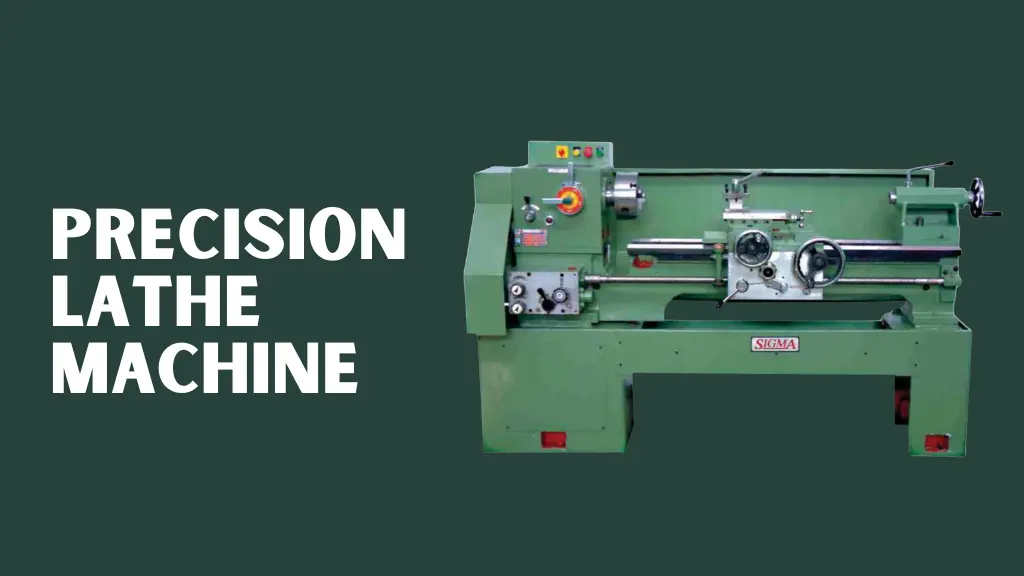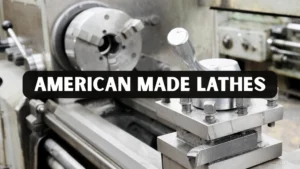Lathes have been at the heart of machining for centuries, evolving from simple woodturning tools into highly advanced systems that drive modern manufacturing. Among the many variations, the precision lathe machine holds a unique place. These machines are designed not just for cutting and shaping materials but for achieving the exactness demanded by industries where even the smallest deviation can compromise performance.
From aerospace components to medical implants and automotive parts, the applications of precision lathes highlight their critical role in shaping industries that rely on accuracy, consistency, and efficiency. This article explores how these machines work, why they matter, their role in different industries, and what to look for when considering one.
Understanding the Precision Lathe Machine
A precision lathe machine is engineered with the primary goal of producing components to exact tolerances, often within a few microns. While a traditional lathe can handle general turning, cutting, and drilling tasks, a precision lathe is built to deliver repeatability and accuracy for complex geometries.
The design of these machines typically emphasizes stability, vibration reduction, and precise spindle control. Hardened guideways, rigid bed structures, and advanced bearings ensure that the spindle remains steady even under demanding conditions. This mechanical integrity allows operators and automated systems to execute detailed cuts that would be impossible on standard lathes.
What distinguishes a precision lathe from a general-purpose machine is its ability to consistently reproduce the same dimensions, surface finish, and alignment across hundreds or thousands of parts. This consistency is what makes it indispensable in industries where safety and reliability are non-negotiable.
The Evolution of Precision Lathes
Lathes have existed since ancient times, but the push for greater accuracy came with the rise of industrial manufacturing. In the late 18th and early 19th centuries, engineers began developing machines capable of creating interchangeable parts. This innovation laid the foundation for modern engineering, where exact measurements became a standard requirement.
With the advent of digital control systems in the 20th century, lathes were transformed into CNC (Computer Numerical Control) machines. Precision lathes benefited significantly from these advances, integrating software-driven accuracy with robust mechanical designs. Today, these machines not only cut and turn but also integrate milling, drilling, and threading capabilities, reducing the need for multiple setups.
Why Precision Matters in Machining
In industries like aerospace, automotive, energy, and healthcare, the margin for error is incredibly small. A turbine blade that is slightly out of alignment can affect fuel efficiency. A medical implant that is even a fraction of a millimeter too large or small can cause patient complications. Precision lathes ensure that such risks are minimized.
The value of precision lies not only in the safety and reliability of finished products but also in cost savings. Poorly machined parts lead to higher rejection rates, wasted materials, and costly rework. By contrast, precision machining reduces scrap, improves cycle efficiency, and builds customer trust in product quality.
Key Features of a Precision Lathe
Unlike standard equipment, advanced lathes are specifically engineered to prioritize both stability and accuracy. Their construction often includes heavy-duty frames, carefully ground spindles, and modern control systems that work together to minimize vibration. This level of design ensures consistent performance, even during long and demanding production cycles. As a result, manufacturers can depend on them to produce parts that meet exact specifications every time.
Modern versions also incorporate live tooling, which allows additional processes like drilling and tapping to be performed without removing the workpiece. By keeping the material in place, the risk of errors caused by repositioning is reduced significantly. This not only enhances accuracy but also shortens cycle times, improving overall productivity in both small and large-scale operations.
At the higher end, these machines may include features such as automated tool changers and digital feedback systems. These technologies allow real-time monitoring and on-the-fly adjustments, giving operators better control and insight into each task. With such capabilities, the machines provide a combination of reliability, flexibility, and efficiency, supporting everything from prototype development to mass production.
Applications Across Industries
The adaptability of precision lathes makes them central to a wide range of sectors. In aerospace, they are used for creating critical engine and structural components. These parts must perform under extreme conditions, making accuracy essential. In automotive manufacturing, lathes handle engine blocks, crankshafts, and transmission components where tolerances determine both performance and efficiency.
The medical sector relies on precision lathes to produce implants, surgical instruments, and prosthetics. These applications require not only dimensional accuracy but also smooth finishes that ensure patient safety and comfort. Energy industries, from oil and gas to renewable power, also benefit from precision lathes for producing parts that must withstand intense pressures and stresses.
By bridging industries with diverse requirements, precision lathes demonstrate their importance as versatile tools capable of meeting the strictest standards.
Choosing the Right High Speed Precision Lathe
Selecting the right precision lathe machine depends on the scale of operations, the materials involved, and the desired level of automation. For small workshops, manual or semi-automatic models may suffice, particularly when custom or low-volume parts are needed. Large-scale manufacturers, however, often invest in fully automated CNC precision lathes to handle high-volume production while ensuring accuracy.
Another consideration is the range of materials to be machined. Different metals, composites, and plastics require specific cutting speeds, tooling, and cooling systems. Machines with adaptive controls and customizable settings provide greater flexibility for handling varied production requirements.
Support and service are equally important. Investing in a reliable brand that provides technical assistance, training, and spare parts ensures long-term productivity. Companies that prioritize operator training also minimize errors and maximize machine efficiency.
Real-World Example Aerospace Manufacturing
To understand the value of precision lathes, consider the aerospace sector. Jet engines require hundreds of parts, each of which must meet strict safety and performance criteria. For example, turbine shafts demand surface finishes that minimize friction and resist wear over thousands of operating hours. Producing these parts without a precision lathe would result in unacceptable risks.
By using advanced precision lathes, manufacturers can achieve exact dimensions repeatedly, even in complex geometries. This consistency is essential not only for safety but also for regulatory compliance. Aviation authorities require that all parts meet predefined standards, and precision lathes are critical tools in achieving that benchmark.
How Precision Reduces Waste and Costs
Efficiency is one of the strongest advantages of modern lathes, providing both cost savings and operational stability. By consistently meeting tight tolerances, they greatly reduce the chances of part rejection. This directly cuts down on wasted raw materials, which is especially important with metals like titanium or stainless steel. The result is improved profitability and stronger trust in the final product’s quality.
Beyond reducing waste, accurate machining also supports just-in-time production methods. Manufacturers can create smaller batches without worrying about inconsistencies, lowering inventory needs. This approach makes supply chains more flexible and responsive to market changes. In turn, companies gain both efficiency and reliability, ensuring long-term competitiveness in demanding industries.
The Future of Precision Lathes
The future of machining is moving rapidly toward automation and intelligent systems that improve efficiency and reduce human error. With the integration of AI-driven controls, manufacturers can program machines to adapt in real time to changing conditions, ensuring consistent quality. Industry 4.0 technologies, such as smart sensors, now enable monitoring of vibrations, spindle alignment, and tool wear, giving operators actionable insights that reduce downtime and extend machine life.
Another major advancement is predictive maintenance powered by data analytics. Instead of waiting for mechanical failures, these systems alert operators to potential problems before they disrupt production. This proactive approach not only saves costs but also boosts trust among clients who rely on manufacturers to deliver precision components without delays. By combining technical innovation with proven reliability, businesses reinforce their commitment to accuracy and long-term performance.
Additive manufacturing is transforming the future of production by enabling complex designs with speed and flexibility. However, 3D-printed components often require refinement to achieve precise tolerances and surface finishes. In this role, the precision lathe machine ensures exactness by complementing additive methods with subtractive accuracy. Together, they create a hybrid workflow that supports both prototyping and large-scale manufacturing with superior quality.
Building Trust Through Accuracy
Companies that invest in precision lathes demonstrate a strong commitment to quality and reliability. This investment signals to customers, partners, and stakeholders that accuracy and consistency are top priorities in their manufacturing process. In industries such as aerospace, automotive, and medical, where a single component failure can lead to costly setbacks or even risk lives, maintaining precision is not just a choice, it’s a necessity.
By consistently producing high-quality parts with precision lathes, manufacturers build long-term trust and credibility in the market. This reliability enhances their reputation, attracts repeat business, and sets them apart from competitors on a global scale. Over time, this commitment to precision not only safeguards their brand image but also provides a sustainable competitive advantage.
Conclusion
The role of the precision lathe machine in modern manufacturing cannot be overstated. From aerospace to healthcare, these machines deliver the accuracy, consistency, and efficiency required to meet today’s demanding standards. Their ability to reduce waste, enhance safety, and build trust makes them more than just tools, they are strategic assets for industries that cannot compromise on quality.
As technology advances, precision lathes will only become more capable, integrating digital intelligence with robust mechanical design. For manufacturers seeking to remain competitive and reliable, the investment in precision machining remains not just important but essential.
FAQs
What makes certain lathes more accurate than others?
The level of accuracy depends on factors such as the rigidity of the machine’s frame, the quality of the spindle bearings, and the ability to minimize vibration. Machines with these features maintain consistent tolerances even during high-volume production.
Which industries benefit the most from high-accuracy machining?
Sectors like aerospace, automotive, medical, and energy benefit greatly. They require parts with exact specifications, where even the smallest error could compromise performance, safety, or compliance with industry standards.
Are all CNC lathes designed for fine-tolerance work?
Not all CNC lathes qualify as high-accuracy systems. While many offer good performance, true fine-tolerance machines combine advanced digital controls with specialized construction to achieve exceptional consistency and surface finishes.
How can these machines be kept reliable over time?
Reliability comes from regular maintenance, which includes cleaning, lubrication, alignment checks, and spindle calibration. Modern equipment often includes built-in monitoring systems that alert operators to potential issues before they become costly problems.




